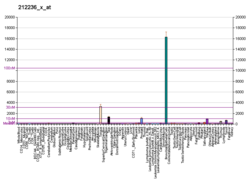Keratin, type I cytoskeletal 17 is a protein that in humans is encoded by the KRT17 gene. [5] [6] [7] [8]
Contents
Keratin 17 is a type I cytokeratin. It is found in nail beds, hair follicles, sebaceous glands, and other epidermal appendages. Mutations in the gene encoding this protein lead to PC-K17 (previously known as Jackson-Lawler) type pachyonychia congenita and steatocystoma multiplex. [8]





